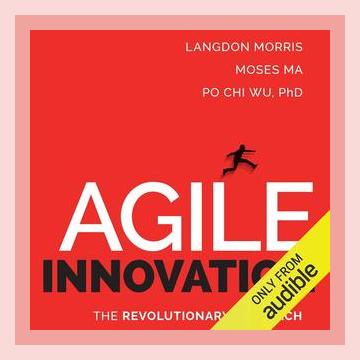Innovation and CreativityIdea Generation
Introduction
“Agile Innovation” combines the principles of agile methodologies with the rapidly evolving domain of innovation management. The authors argue that businesses must adapt to the fast-paced changes of the modern world through agile innovative strategies. They integrate insights from agile software development into broader business processes, emphasizing the need for speed, flexibility, and collaboration.
1. The Need for Agile Innovation
Point: Traditional innovation processes are often too slow to keep up with the rapidly changing business environment.
Action: Adopt an agile mindset by breaking down innovation projects into shorter cycles or sprints. This allows for continuous feedback and iteration.
Example: The authors highlight how IBM incorporated agile methodologies to develop their Watson AI. This approach enabled faster iterations and more effective problem-solving.
2. Principles of Agile Development
Point: Agile development centers around incremental progress, team collaboration, and customer feedback.
Action: Form cross-functional teams that include members from different departments to ensure diverse perspectives and rapid iteration.
Example: Spotify uses “squads,” small, autonomous teams responsible for different aspects of the platform. Each squad operates like a mini-startup, allowing for rapid innovation and adaptation.
3. Building an Agile Culture
Point: An organization’s culture must support agility for these methods to be effective. This includes embracing change and encouraging experimentation.
Action: Establish a culture of open communication where team members can freely share ideas and feedback.
Example: At Google, the “20% time” policy encourages employees to spend 20% of their time on projects they are passionate about, fostering innovation and creative solutions.
4. Customer-Centric Innovation
Point: Innovation must focus on creating value for customers. Engage customers early and often to ensure their needs are met.
Action: Implement regular customer feedback loops through surveys, interviews, and focus groups to validate ideas and features early in the development process.
Example: IDEO uses design thinking, which places the user’s needs and experiences at the center of the innovation process, leading to products that better satisfy consumer demands.
5. Agile Processes and Tools
Point: Utilize agile tools and techniques such as Scrum, Kanban, and Lean to manage innovation projects.
Action: Adopt the Scrum framework by conducting daily stand-ups, sprint planning, and retrospectives to maintain alignment and improve continuously.
Example: Salesforce effectively manages its product development using Scrum. By doing so, they maintain a high level of flexibility and responsiveness to customer needs and market changes.
6. Measuring Innovation Success
Point: Success in innovation should be measured not only by outputs but by outcomes and impacts.
Action: Develop a balanced scorecard that includes metrics such as time to market, customer satisfaction, and return on innovation (ROI).
Example: 3M uses a combination of quantitative and qualitative measures to evaluate the impact of their innovative projects, focusing on market adoption and customer feedback.
7. Speed and Flexibility
Point: The ability to pivot quickly is crucial in the agile innovation process to respond to emerging opportunities or challenges.
Action: Establish a decision-making framework that allows teams to quickly evaluate and respond to new information.
Example: Netflix’s transition from DVD rental to streaming services is a prime example of a company that could pivot its business model swiftly to keep pace with technological advancements and market demand.
8. Risk Management in Agile Innovation
Point: Risk should be managed through iterative cycles that help identify issues early and allow for adjustments.
Action: Conduct regular risk assessments and adjust project plans based on the findings.
Example: Zara’s supply chain management leverages an agile model that enables them to adapt quickly to fashion trends and mitigate risks associated with unsold inventory.
9. Collaboration and Team Dynamics
Point: High levels of collaboration and team cohesion are essential for agile innovation.
Action: Implement team-building activities and tools that promote collaboration, such as shared whiteboards and collaborative software platforms.
Example: At Pixar, the “brain trust” meeting, where directors get feedback from peers without hierarchical barriers, promotes collaborative problem-solving and creativity.
10. Continuous Learning and Development
Point: Continuous improvement is key to sustaining innovation. Encourage a culture where learning and development are prioritized.
Action: Invest in training programs and provide access to resources that help employees stay updated with the latest trends and skills.
Example: Amazon’s “Career Choice” program pre-pays 95% of tuition for courses in in-demand fields, reflecting the company’s commitment to employee growth and skill development.
11. Inclusion and Diversity in Innovation
Point: Diverse teams are more innovative because they bring different perspectives and ideas to the table.
Action: Actively recruit team members from varied backgrounds and foster an inclusive environment where all voices are heard.
Example: Apple’s diverse leadership team, which includes various genders and ethnicities, contributes to the company’s innovative culture by bringing a wide range of perspectives to decision-making processes.
12. Scaling Agile Innovation
Point: Scaling agile practices across an organization requires alignment and consistency in processes and goals.
Action: Implement a unified agile framework across departments to ensure that all teams are aligned with the organization’s innovation strategy.
Example: Spotify’s “tribe model” allows for scalable agile practices where multiple squads work on different features, but all aligned with the overall company strategy.
Conclusion
“Agile Innovation” emphasizes the critical intersection of agile methodologies and innovation management. The actionable insights and examples provided by the authors offer a roadmap for organizations aiming to thrive in a fast-paced, ever-changing business environment. By fostering a culture of agility, collaboration, and continuous improvement, companies can drive meaningful innovation and maintain a competitive edge.
Implementing the strategies from “Agile Innovation” requires commitment and adaptability, but the potential rewards include faster time-to-market, higher customer satisfaction, and sustainable business growth.
